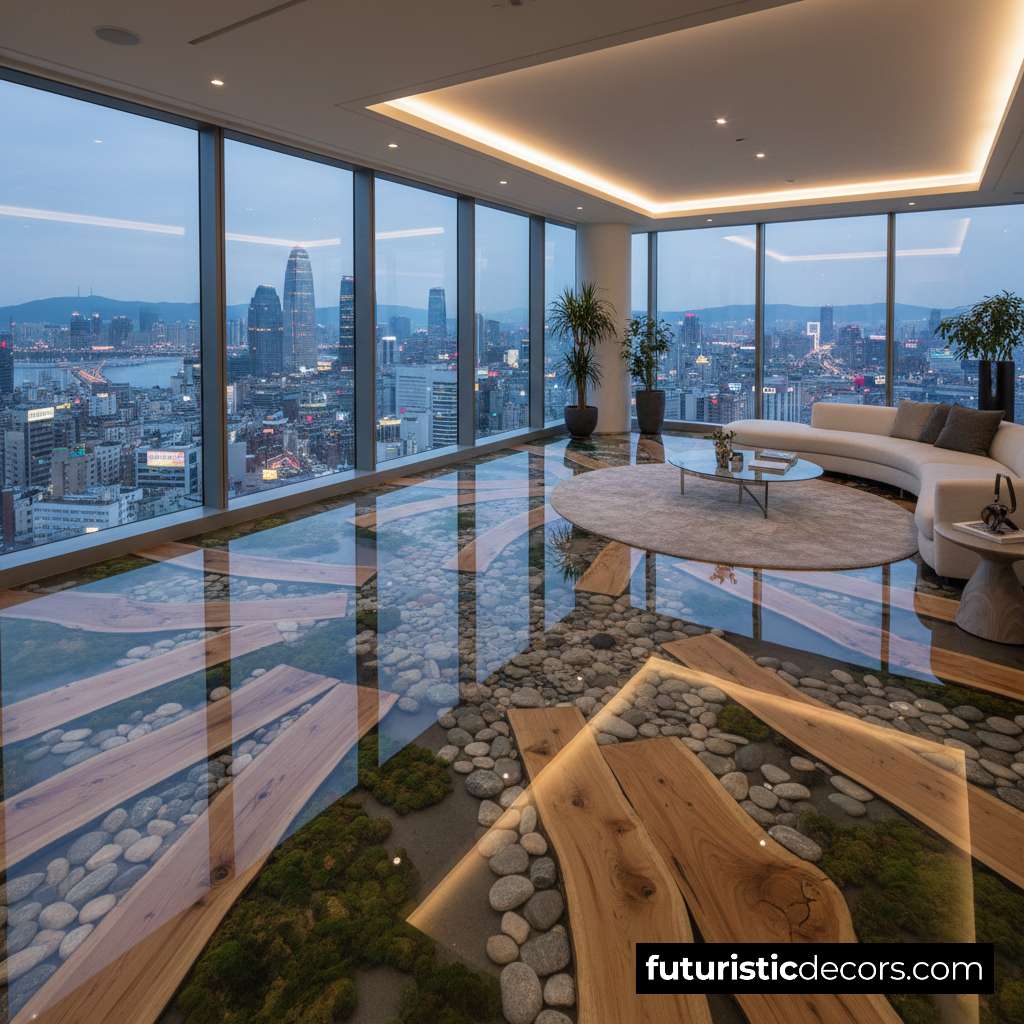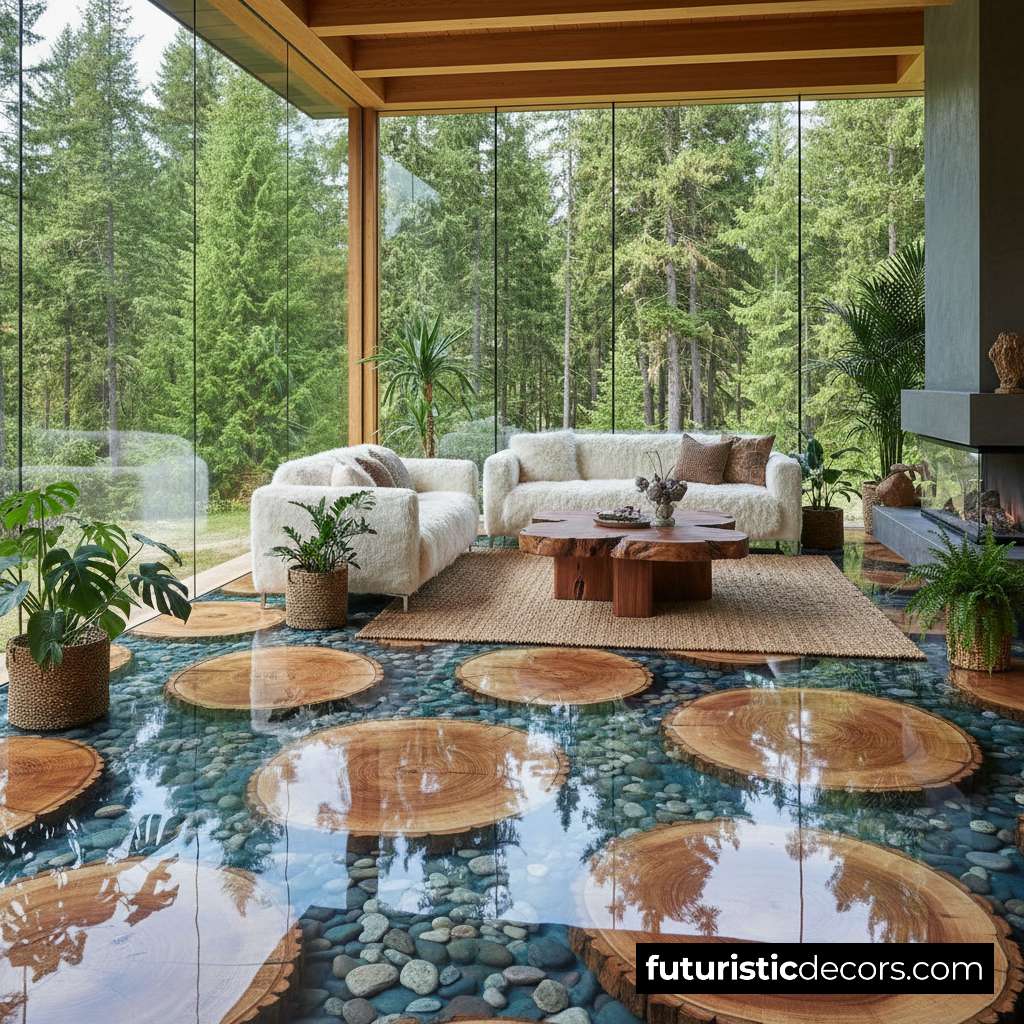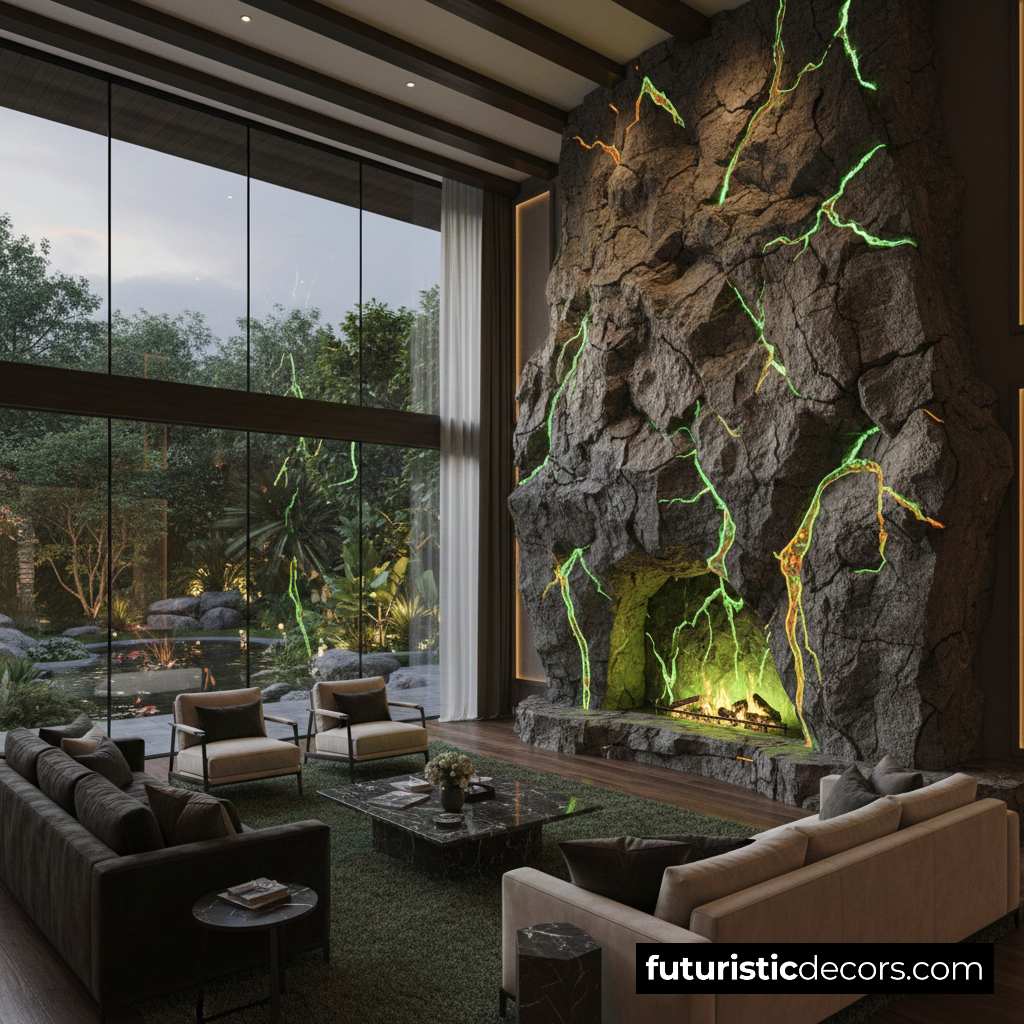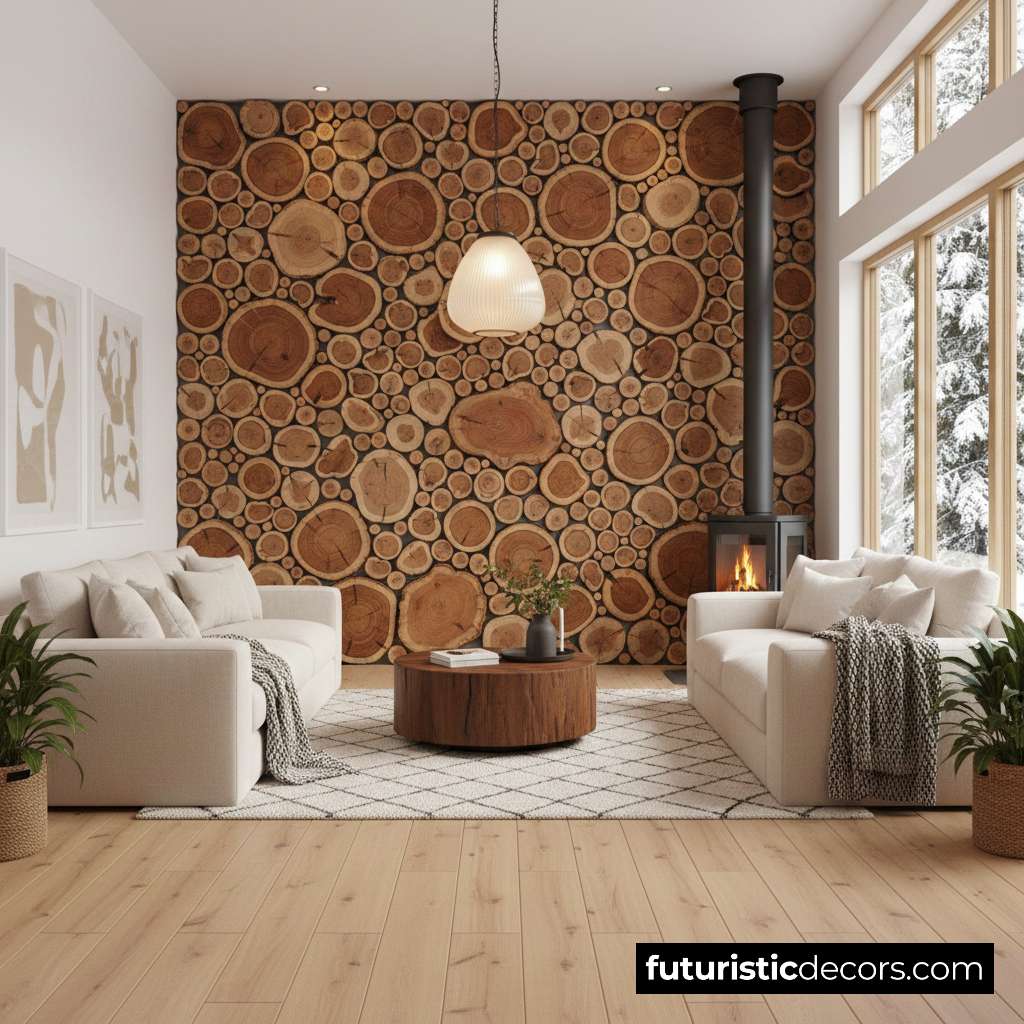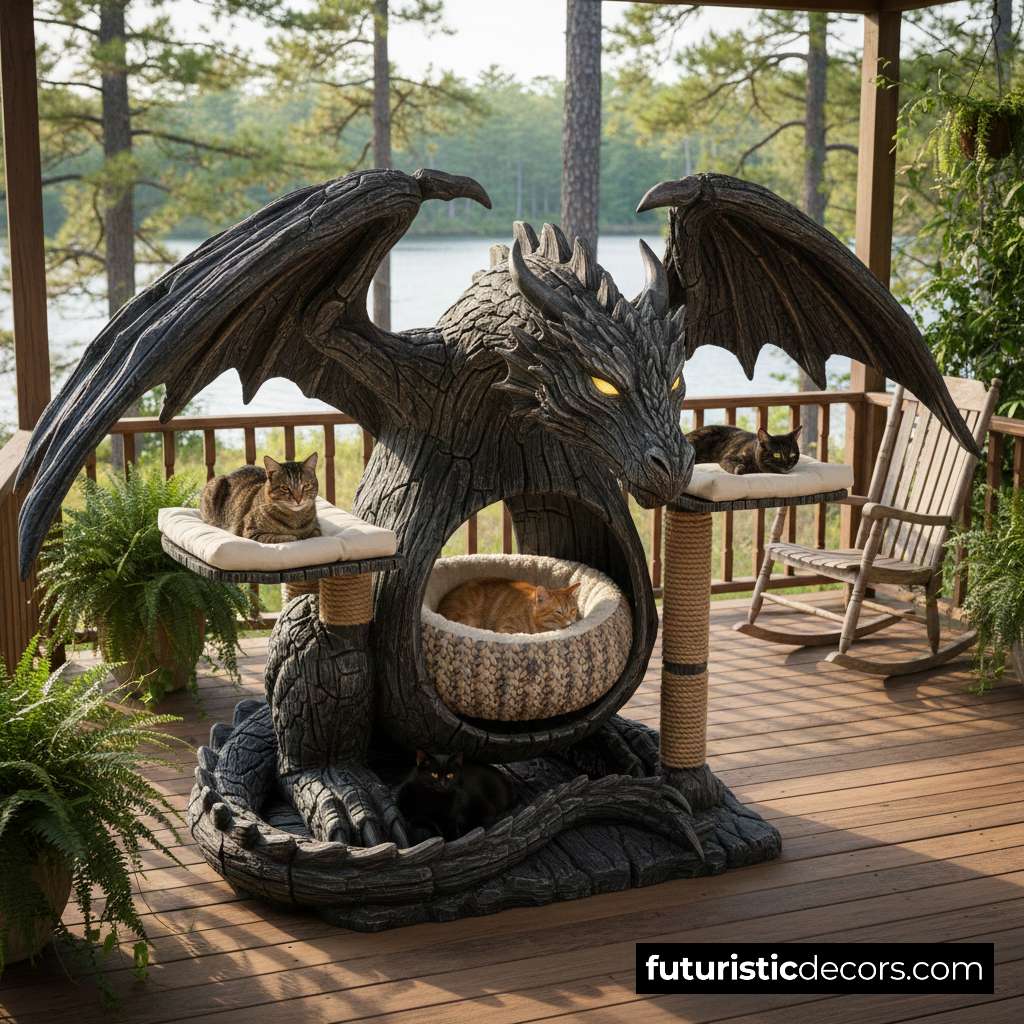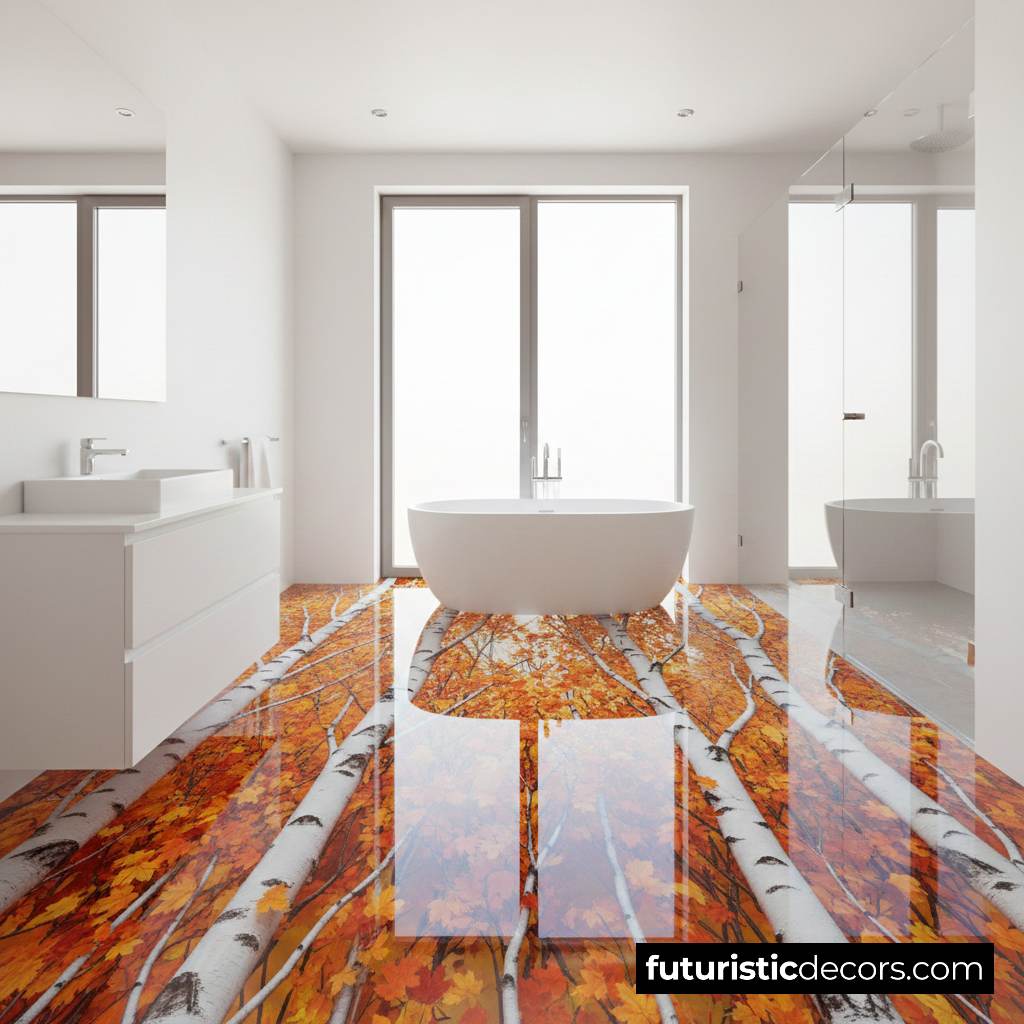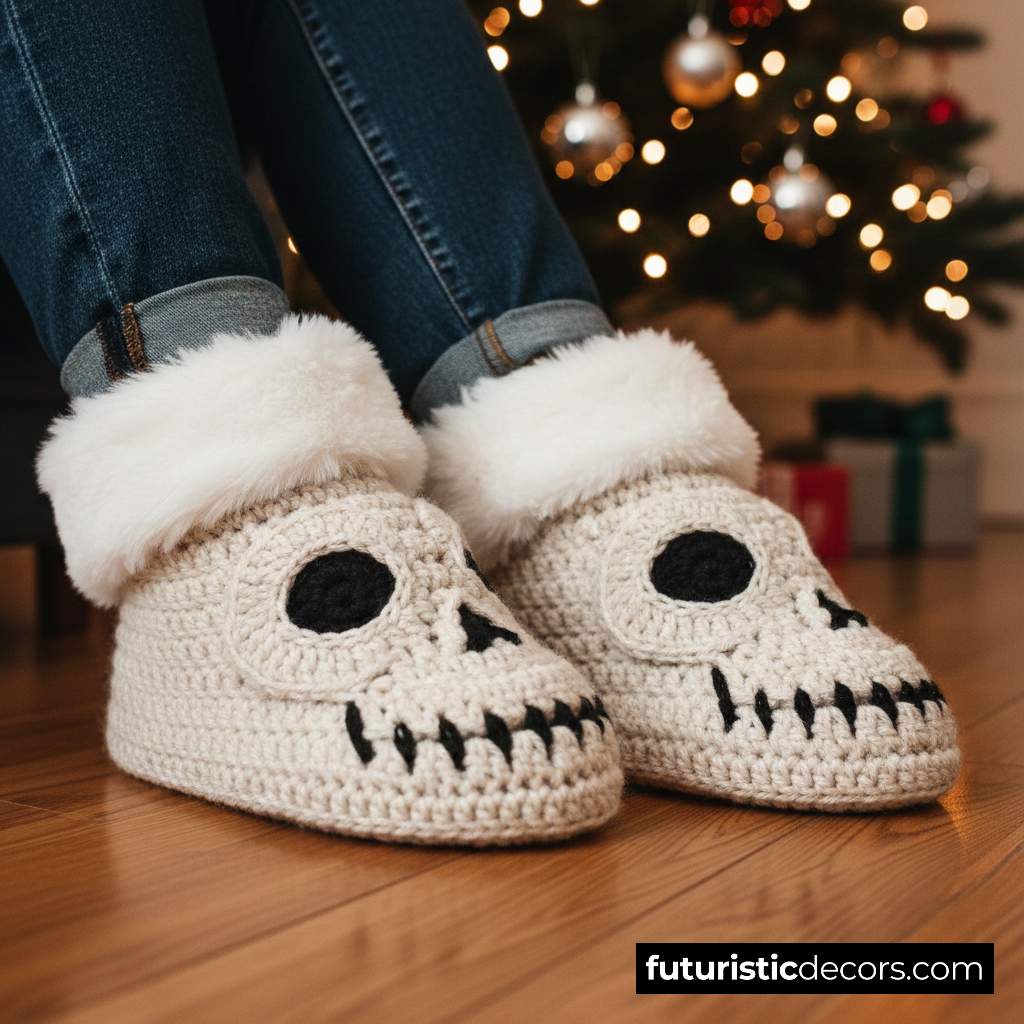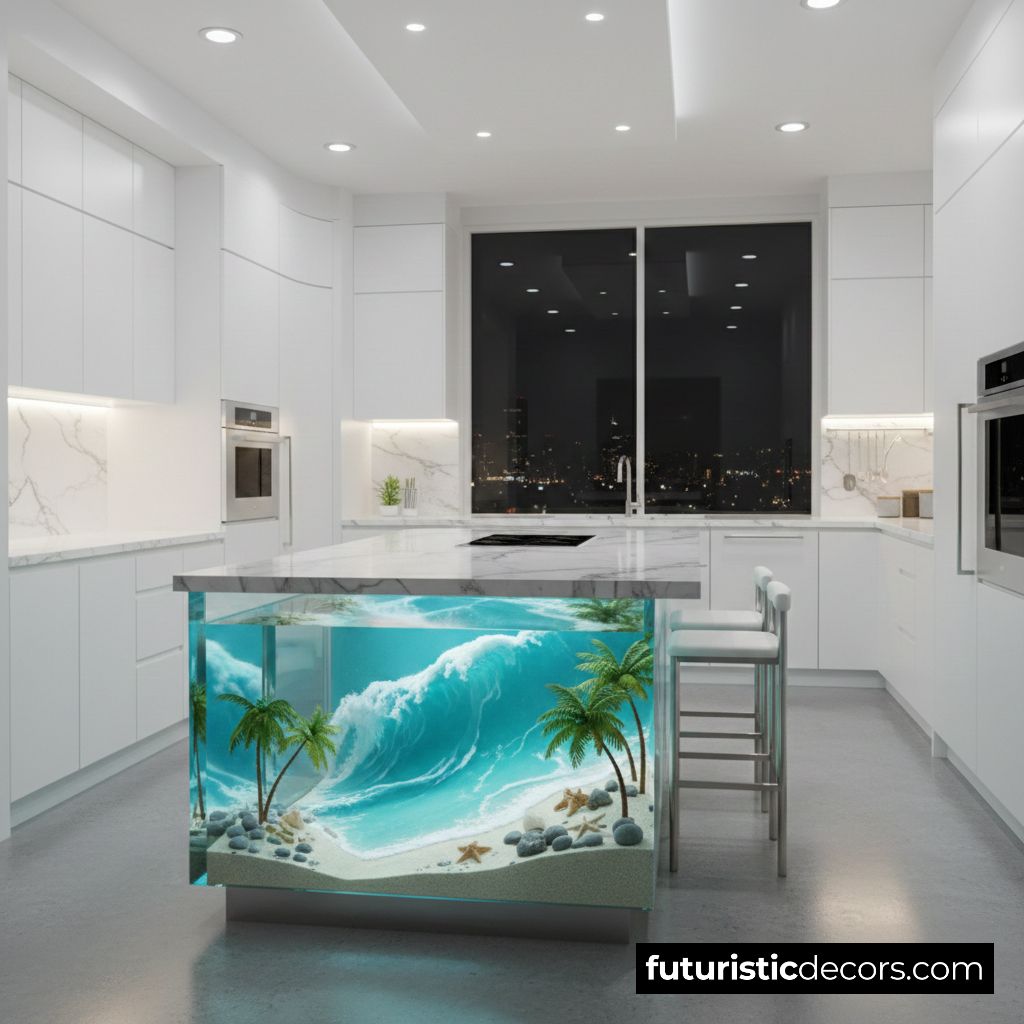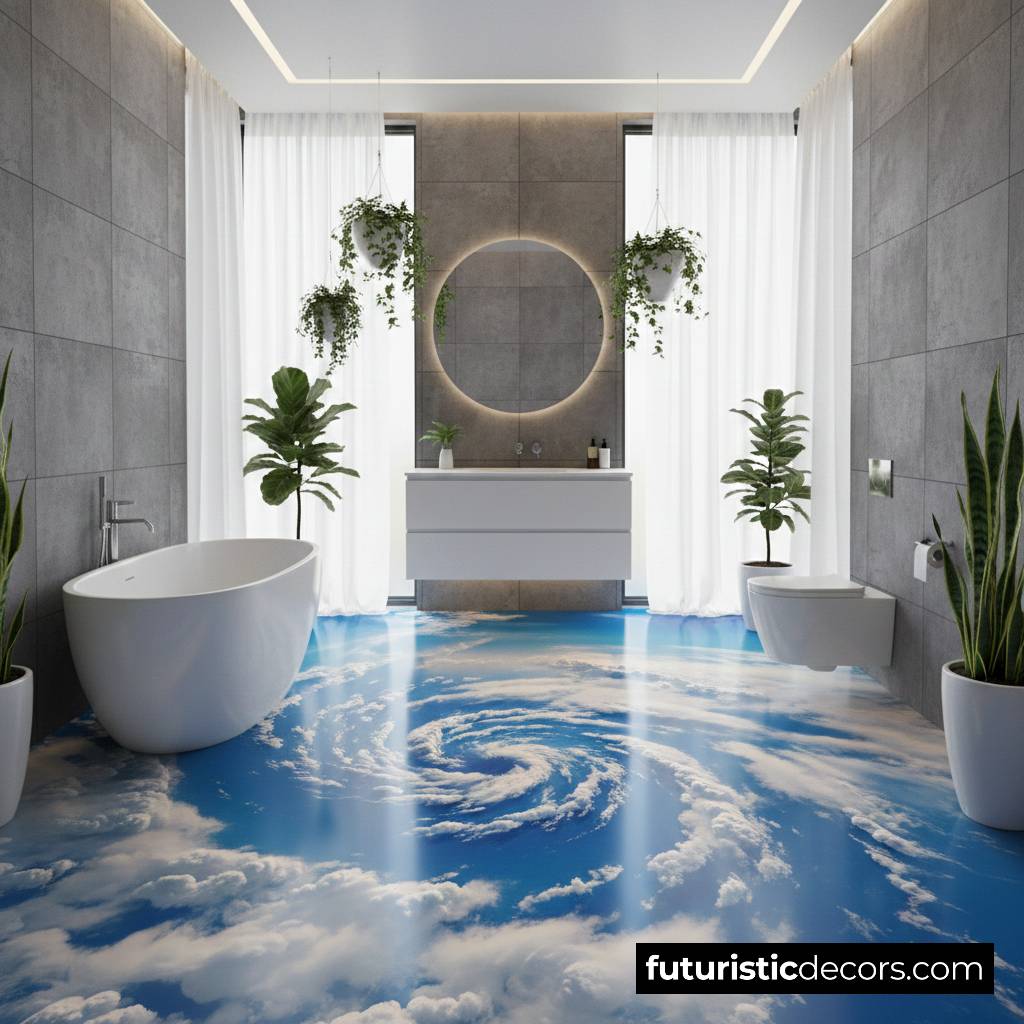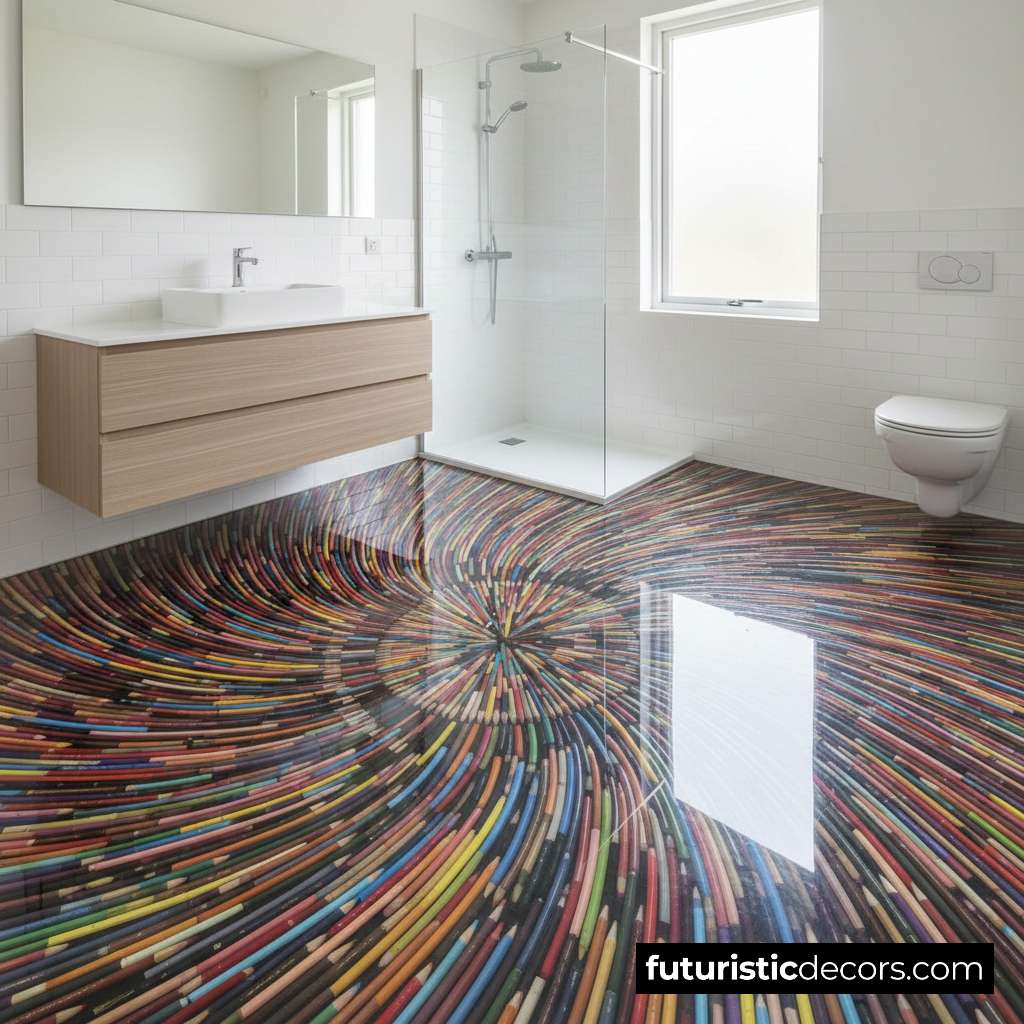In the ever-evolving world of home comfort and outdoor leisure, House Loungers have emerged as a revolutionary solution for those seeking both convenience and luxury. These inflatable lounge houses are not just a passing trend; they represent a significant shift in how we perceive relaxation spaces within and outside our homes. This comprehensive guide delves deep into the world of House Loungers, exploring their features, benefits, and the reasons behind their soaring popularity.
The Rise of House Loungers
The concept of lounging has been redefined over the years, moving from simple recliners to sophisticated setups that cater to our desire for comfort and style. House Loungers have taken this evolution a step further by introducing inflatable lounge houses that are portable, easy to set up, and versatile in use.
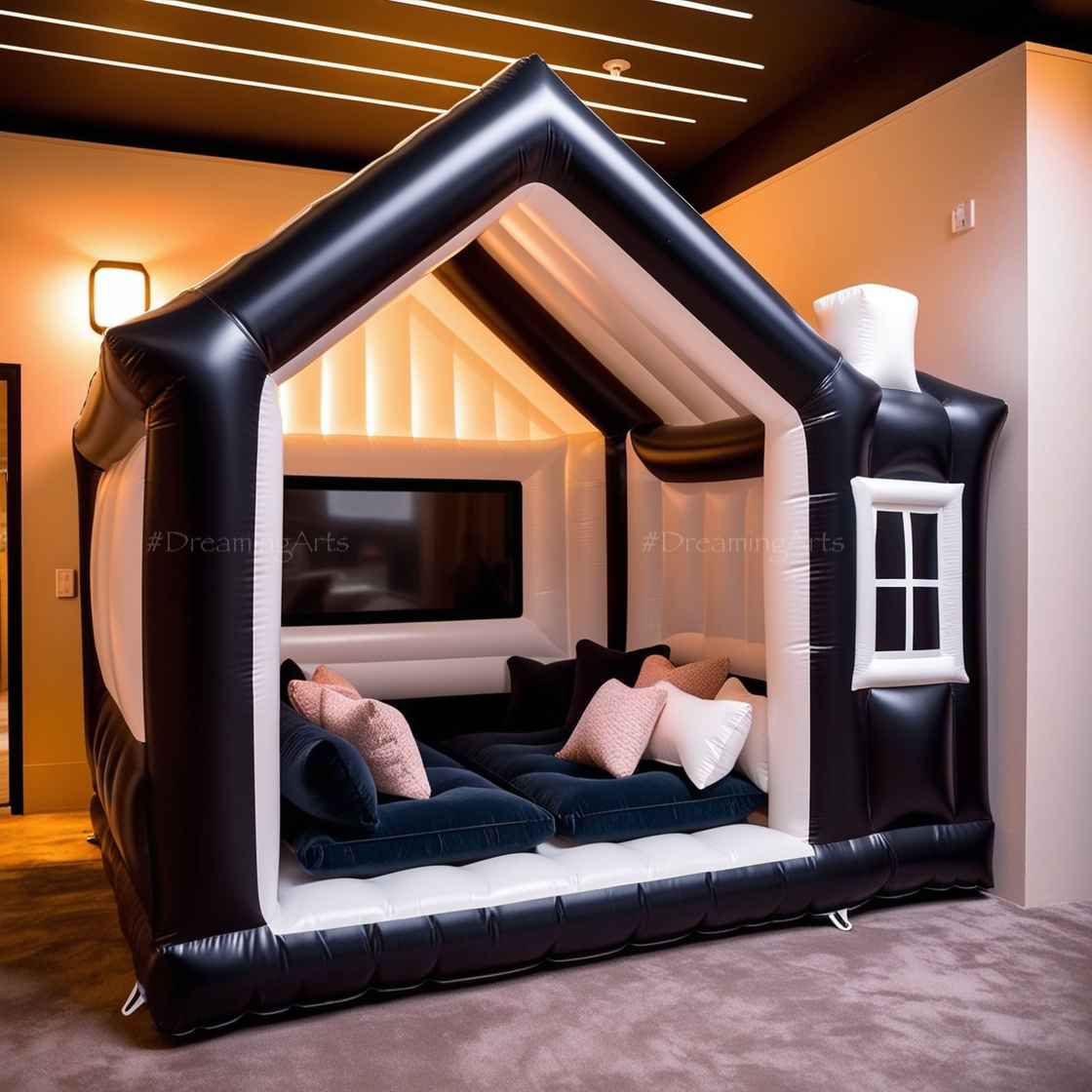
A Brief History
The idea of inflatable furniture isn’t new. Inflatable chairs and sofas gained popularity in the late 1960s and early 1970s as quirky, space-saving options. However, the materials and technology at the time limited their durability and comfort. Today’s House Loungers have overcome these limitations through advancements in material science and design engineering, offering products that are both robust and comfortable.

What Are House Loungers?
At their core, House Loungers are inflatable structures designed to provide a comfortable lounging space that can mimic the feel of a traditional room or outdoor lounge area. They come in various sizes and designs, from single-person pods to large family-sized tents, all emphasizing ease of use and portability.
Key Features
- Portability: One of the standout features of House Loungers is their portability. They can be deflated and packed into compact bags, making them ideal for camping trips, beach outings, or even backyard relaxation.
- Ease of Setup: Most House Loungers boast quick inflation times, some even featuring automatic pumps that can inflate the structure within minutes.
- Durable Materials: Made from high-quality, puncture-resistant materials like PVC or reinforced nylon, these loungers are built to withstand various environmental conditions.
- Comfort and Style: With ergonomic designs and stylish exteriors, House Loungers offer a comfortable and aesthetically pleasing space to unwind.
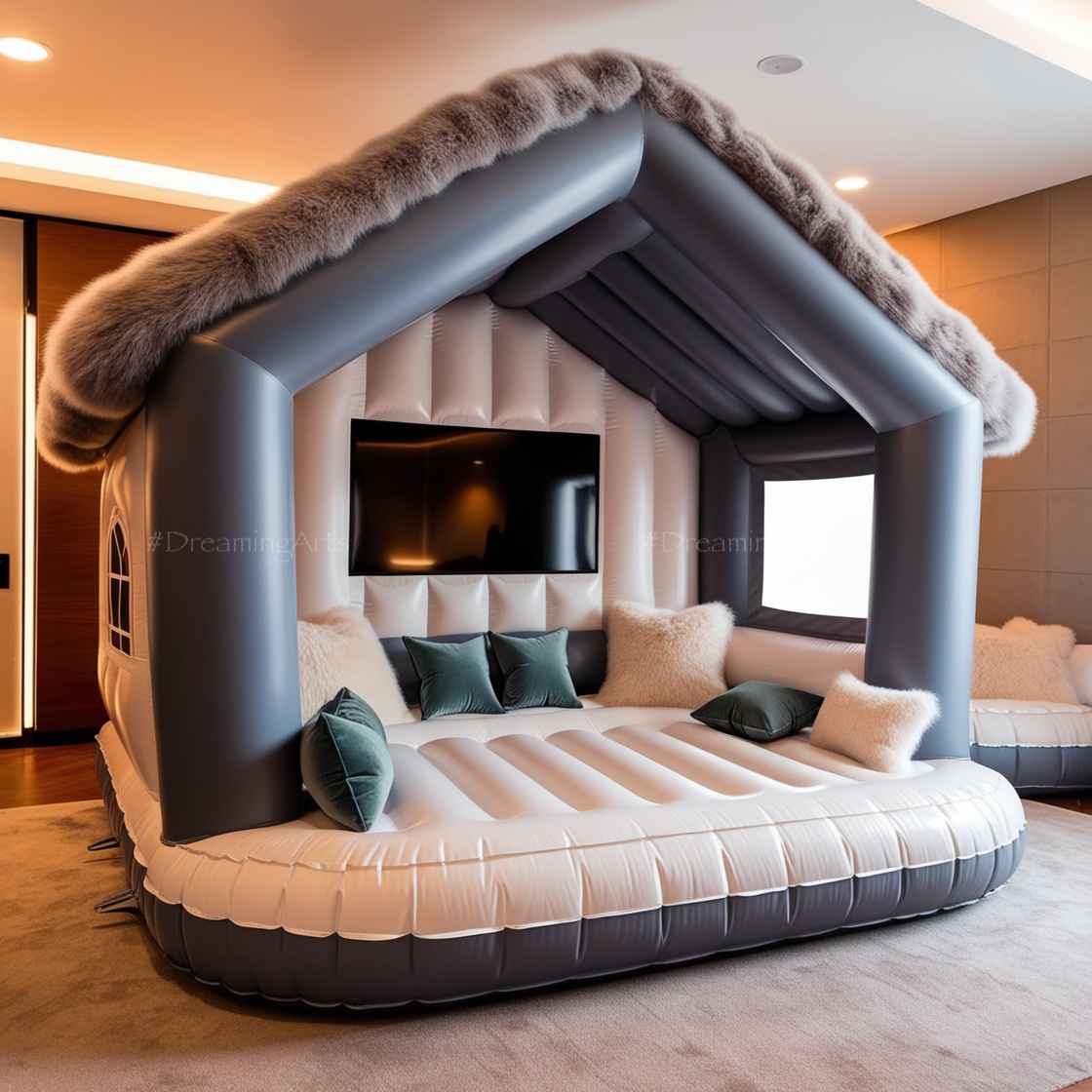
Types of House Loungers
The market offers a diverse range of House Loungers to suit different needs and preferences. Here’s a breakdown of the most popular types:
Inflatable Lounge Tents
These are larger structures designed to accommodate multiple people. They often feature windows, doors, and even separate compartments, providing a mini-house experience.
Single-Person Pods
Ideal for solo relaxation, these pods are compact and perfect for reading, meditation, or a quiet nap.
Hammock Loungers
Combining the comfort of a hammock with the convenience of an inflatable, these House Loungers can be set up between trees or with a stand.
Pool Loungers
Designed for use in swimming pools, these loungers allow you to float and relax on the water, soaking up the sun.
Benefits of Using House Loungers
Versatility
Whether you’re at the beach, in your backyard, or on a camping trip, House Loungers adapt to your environment, providing a comfortable space wherever you are.

Space-Saving
For those with limited space, especially in urban settings, House Loungers offer a practical solution. They can be deflated and stored away when not in use, freeing up valuable space.
Cost-Effective
Compared to building a permanent structure or purchasing traditional outdoor furniture, House Loungers are a more affordable option without compromising on comfort.
Quick Assembly
Time is precious, and the quick setup of House Loungers ensures you spend more time relaxing and less time dealing with complicated assembly instructions.
How to Choose the Right House Lounger
Selecting the perfect House Lounger depends on several factors. Here’s what to consider:
Purpose
Determine where and how you’ll use the lounger. Is it for indoor relaxation, outdoor adventures, or poolside lounging?
Size and Capacity
Consider how many people will use the lounger. Ensure the size and weight capacity meet your requirements.
Material Quality
Look for loungers made from durable, high-quality materials that are resistant to punctures and weather elements.
Additional Features
Some House Loungers come with built-in features like cup holders, storage pockets, or even LED lighting. Decide which extras are important to you.
Budget
Prices can vary widely. Set a budget beforehand to narrow down your options without overspending.
Maintenance and Care
To extend the life of your House Lounger, proper maintenance is essential.
Regular Cleaning
Wipe down the lounger after use, especially if it’s been exposed to sand, dirt, or chlorinated water.
Proper Storage
Ensure the lounger is completely dry before deflating and storing it to prevent mold and mildew growth.
Repairs
Keep a repair kit handy. Small punctures or leaks can often be fixed easily without professional help.
Environmental Impact
As consumers become more environmentally conscious, the sustainability of products like House Loungers comes into focus.
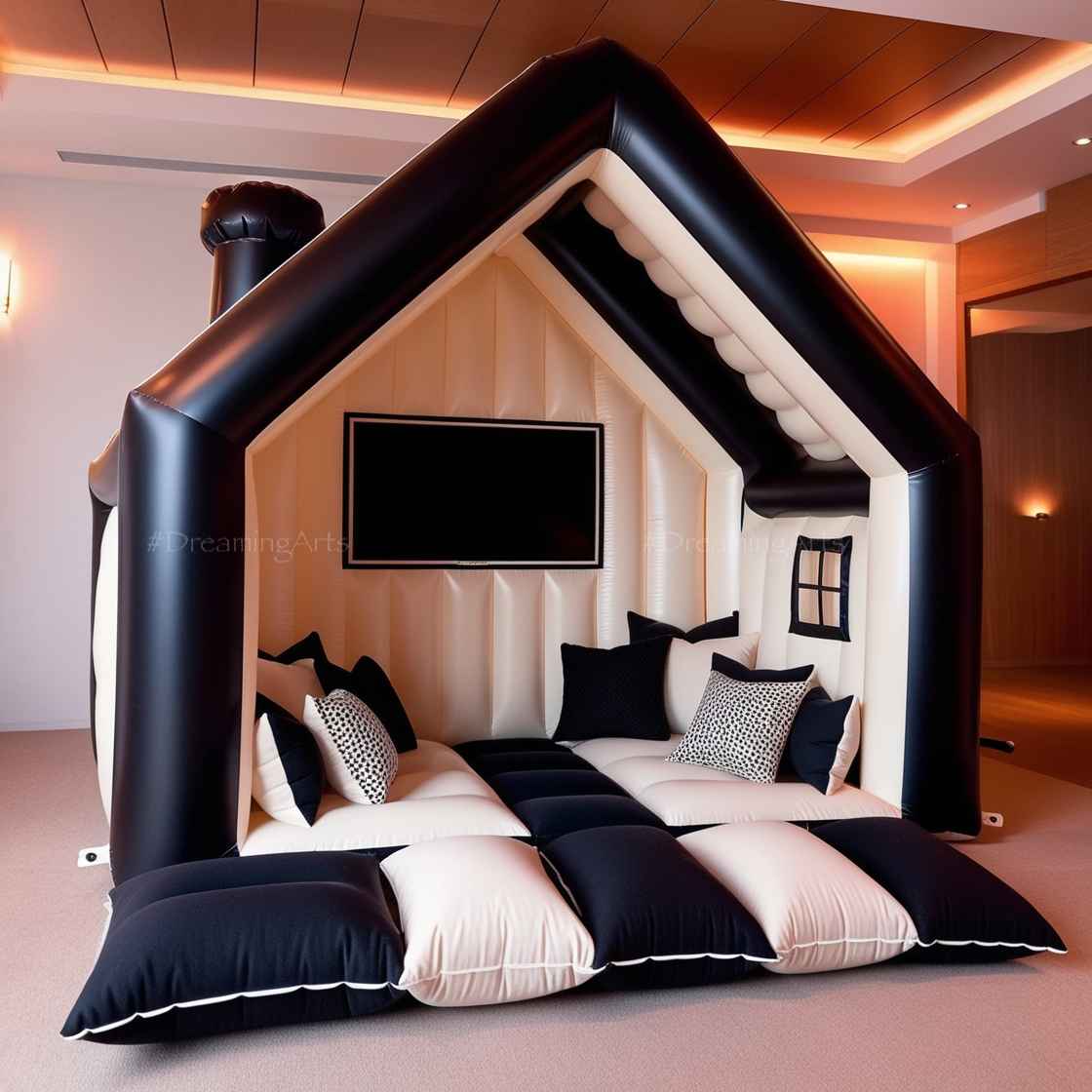
Eco-Friendly Materials
Some manufacturers are now producing House Loungers using biodegradable or recycled materials, reducing their environmental footprint.
Longevity
High-quality House Loungers that last longer contribute to less waste, emphasizing the importance of investing in durable products.
The Future of House Loungers
The popularity of House Loungers shows no signs of waning. Innovations in design and technology continue to enhance their appeal.
Smart Features
The integration of technology, such as solar-powered charging ports or Bluetooth speakers, is becoming more common in newer models.
Customization
Manufacturers are offering more customization options, allowing consumers to choose colors, patterns, and additional features that suit their personal style.
Sustainable Practices
As the demand for eco-friendly products grows, we can expect to see more House Loungers made from sustainable materials and production methods.
Top Brands and Models
While there are many brands on the market, a few stand out for their quality and innovation.

AeroLounge Deluxe
Known for its quick inflation and durable materials, the AeroLounge Deluxe is a top choice for outdoor enthusiasts.
ComfortCasa Inflatable Tent
This House Lounger offers ample space and features UV protection, making it ideal for beach outings.
SoloZen Pod
Perfect for solo relaxation, the SoloZen Pod combines comfort with portability, making it a favorite among travelers.
Testimonials
Sarah’s Experience
“I purchased a House Lounger for our family camping trip, and it was a game-changer. It provided a cozy space for us to relax after a day of hiking.”
Mark’s Review
“As someone who lives in a small apartment, the House Lounger has been fantastic. I can set it up when I have guests over and store it away easily.”
Frequently Asked Questions
Are House Loungers safe for children?
Yes, most House Loungers are safe for children. However, always supervise young kids and ensure the lounger is properly inflated and stable.
How long does it take to inflate a House Lounger?
Inflation times vary by model but generally range from 5 to 15 minutes, especially with electric or battery-powered pumps.
Can I use a House Lounger indoors?
Absolutely! House Loungers are versatile and can be used both indoors and outdoors.
What if my House Lounger gets a puncture?
Many loungers come with a repair kit. Small punctures can often be patched up easily.
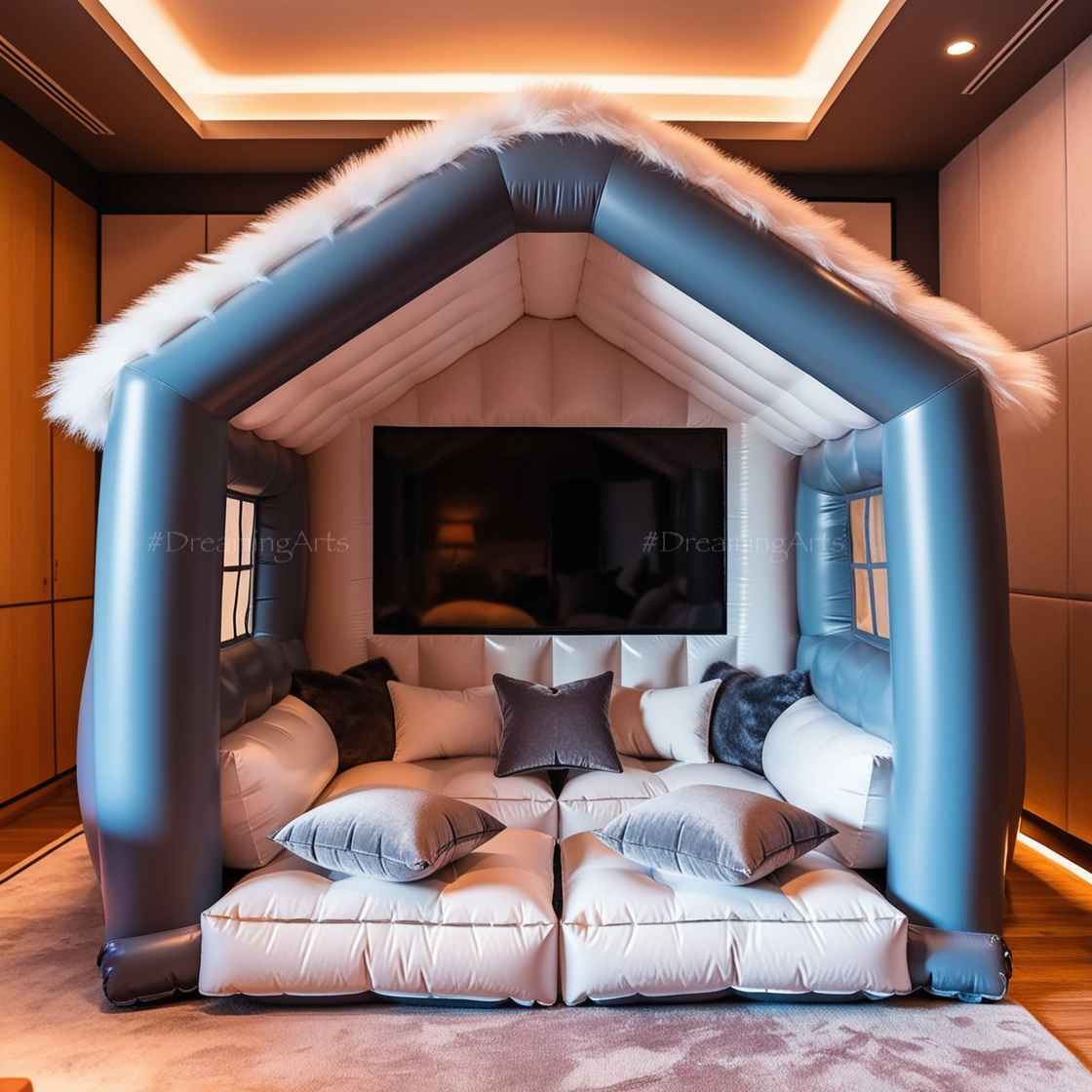
Tips for First-Time Buyers
- Read Reviews: Before purchasing, read customer reviews to get insights into the product’s performance and durability.
- Check Warranty: A good warranty indicates the manufacturer’s confidence in their product.
- Consider Accessories: Think about additional items you might need, like an air pump or protective groundsheet.
- Test Before Use: Inflate your House Lounger at home to familiarize yourself with the setup process.
- Where to Buy House Loungers
With the surge in popularity of House Loungers, numerous retailers both online and offline have started offering a wide range of options. Here’s where you can find the best deals and selections.
Online Marketplaces
- Amazon: A vast selection of House Loungers from various brands, with customer reviews to help you make an informed decision.
- eBay: Offers both new and used loungers, sometimes at discounted prices.
- Etsy: For handcrafted or uniquely designed House Loungers, Etsy provides options from individual sellers.
Specialty Stores
- Outdoor Recreation Stores: Retailers like REI or Decathlon often carry high-quality House Loungers suitable for camping and outdoor activities.
- Home Decor Boutiques: Stores specializing in home furnishings may offer designer loungers that blend functionality with style.

Direct from Manufacturers
Purchasing directly from the manufacturer’s website can sometimes provide benefits like extended warranties or exclusive models. Brands like ComfortCasa and AeroLounge often have online stores with the latest offerings.
DIY House Loungers: Crafting Your Personal Oasis
For the creatively inclined, making your own House Lounger can be a rewarding project. While it requires time and effort, a DIY lounger allows you to customize every aspect to your liking.
Materials Needed
- Inflatable Base: You can repurpose an inflatable mattress as the foundation.
- Fabric Cover: Choose a durable, weather-resistant fabric for outdoor use.
- Accessories: Add pillows, cushions, or even LED lights for ambiance.
Steps to Create
- Design Planning: Sketch your ideal House Lounger, noting dimensions and features.
- Assemble Materials: Gather all necessary materials, ensuring compatibility.
- Construction: Start with the inflatable base, then add the fabric cover, securing it properly.
- Customization: Incorporate additional features like pockets or cup holders.
- Testing: Inflate and test your lounger for comfort and stability.
Benefits of DIY
- Cost Savings: Often cheaper than purchasing a high-end model.
- Customization: Tailor every detail to suit your preferences.
- Satisfaction: Enjoy the accomplishment of creating something with your own hands.
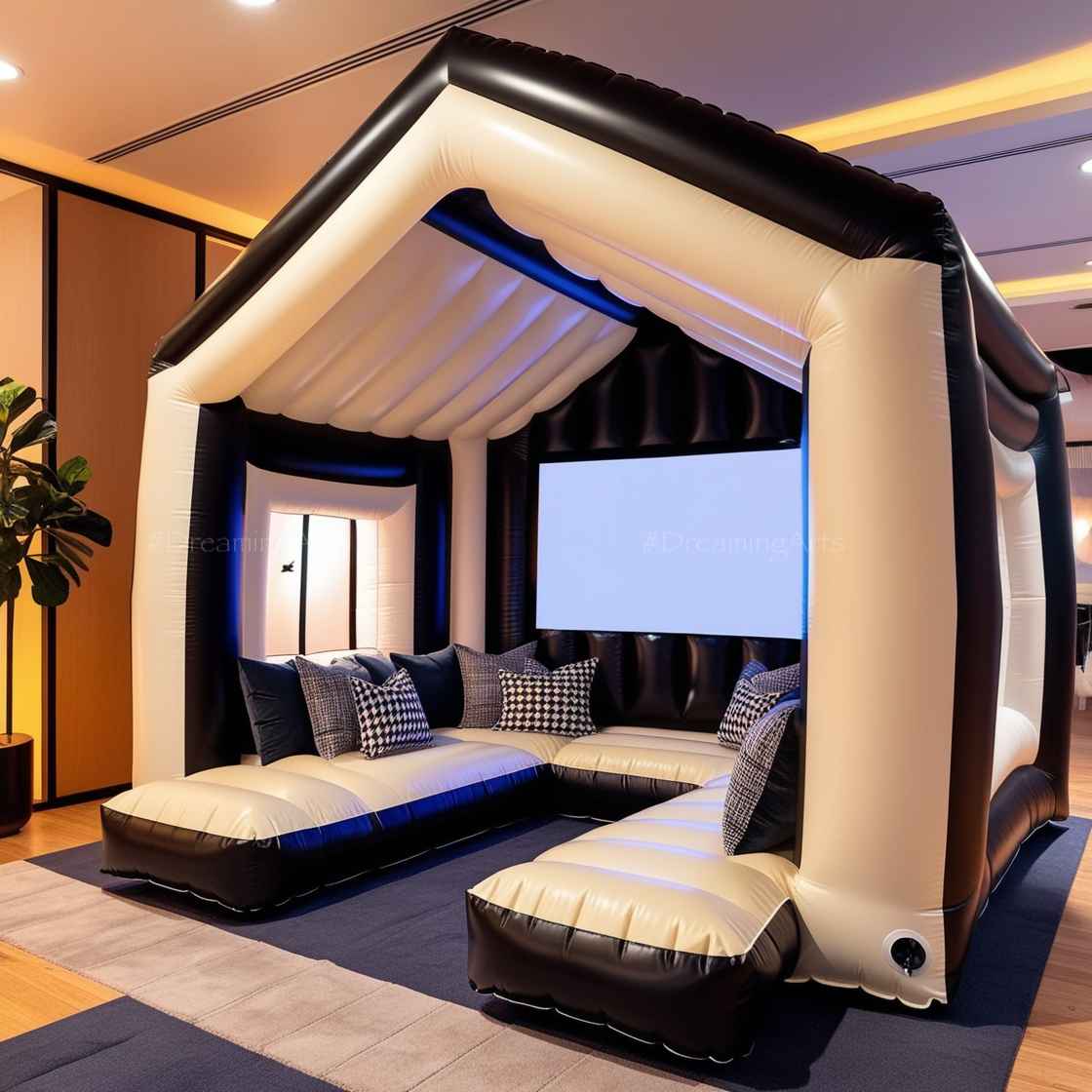
Hosting Events with House Loungers
House Loungers aren’t just for personal relaxation; they’re also fantastic for hosting social gatherings.
Backyard Parties
Transform your backyard into a cozy lounge area. Arrange multiple House Loungers to create seating zones, encouraging guests to mingle and relax.
Beach Gatherings
Take your House Loungers to the beach for a day of fun in the sun. They provide a comfortable spot to rest between swimming sessions and are easy to pack up at the end of the day.
Movie Nights
Set up an outdoor cinema and use House Loungers as seating. Their comfort enhances the viewing experience, making movie nights memorable.
Combining House Loungers with Other Outdoor Gear
Enhance your outdoor experience by pairing your House Lounger with complementary equipment.
Sun Shades and Canopies
Protect yourself from the elements by using sun shades or canopies. This combination is perfect for hot days when you need some respite from direct sunlight.
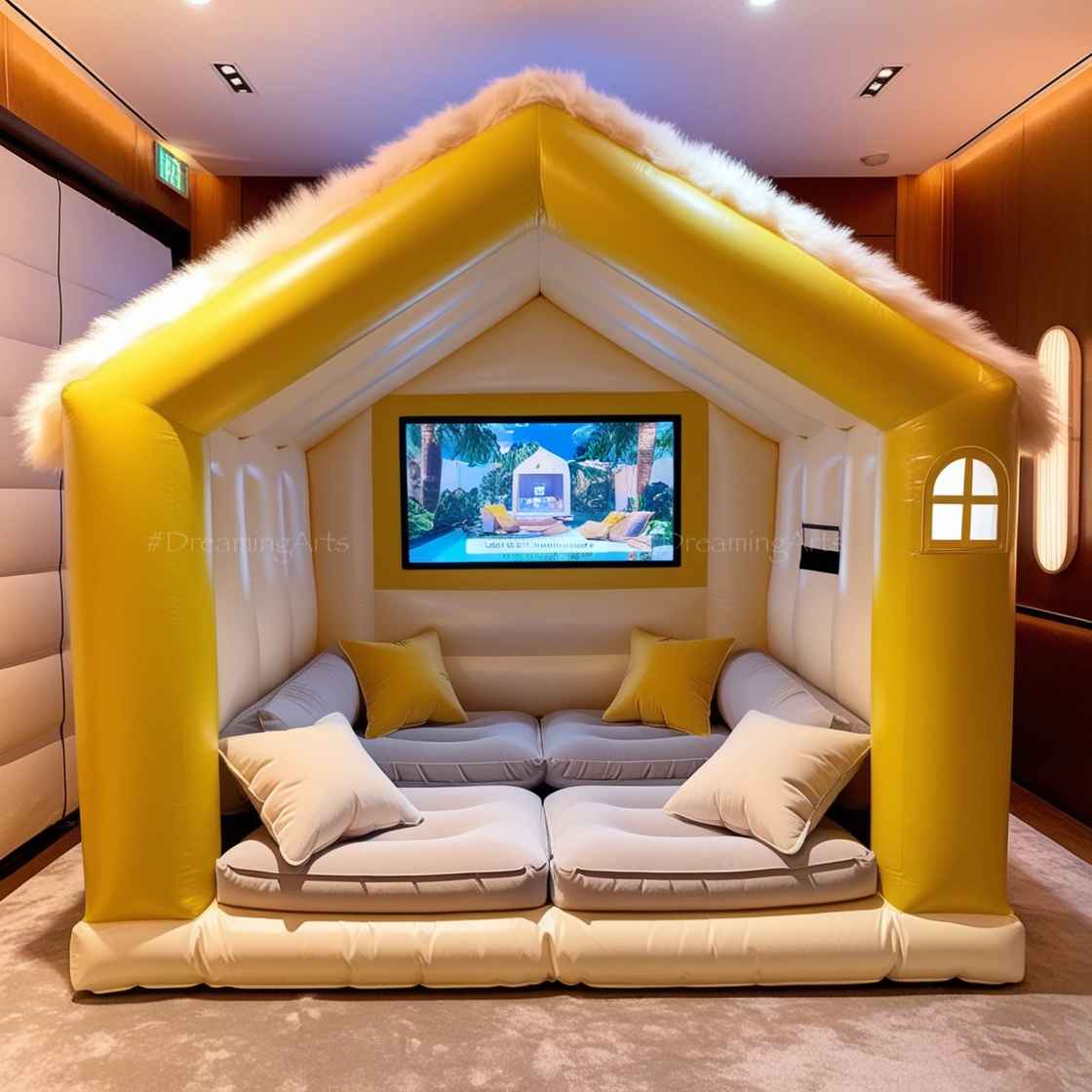
Portable Heaters
Extend the usability of your House Lounger into cooler seasons by adding portable heaters. This setup allows you to enjoy the crisp autumn air in comfort.
Outdoor Speakers
Set the mood with some music. Portable, waterproof speakers can create an immersive environment, whether you’re relaxing alone or entertaining guests.
Health Benefits of Using House Loungers
Beyond leisure, House Loungers offer several health advantages.
Stress Reduction
Lounging in a comfortable environment helps reduce stress levels. The relaxation promotes mental well-being and can improve mood.
Improved Sleep
For those who struggle with sleep, napping in a House Lounger can be beneficial. The gentle swaying of certain models can induce sleepiness.
Posture Support
High-quality House Loungers are designed to support the body’s natural posture, reducing the risk of back pain associated with poorly designed seating.
Cultural Impact of House Loungers
The rise of House Loungers reflects broader cultural trends towards flexible living spaces and a desire for multifunctional furniture.
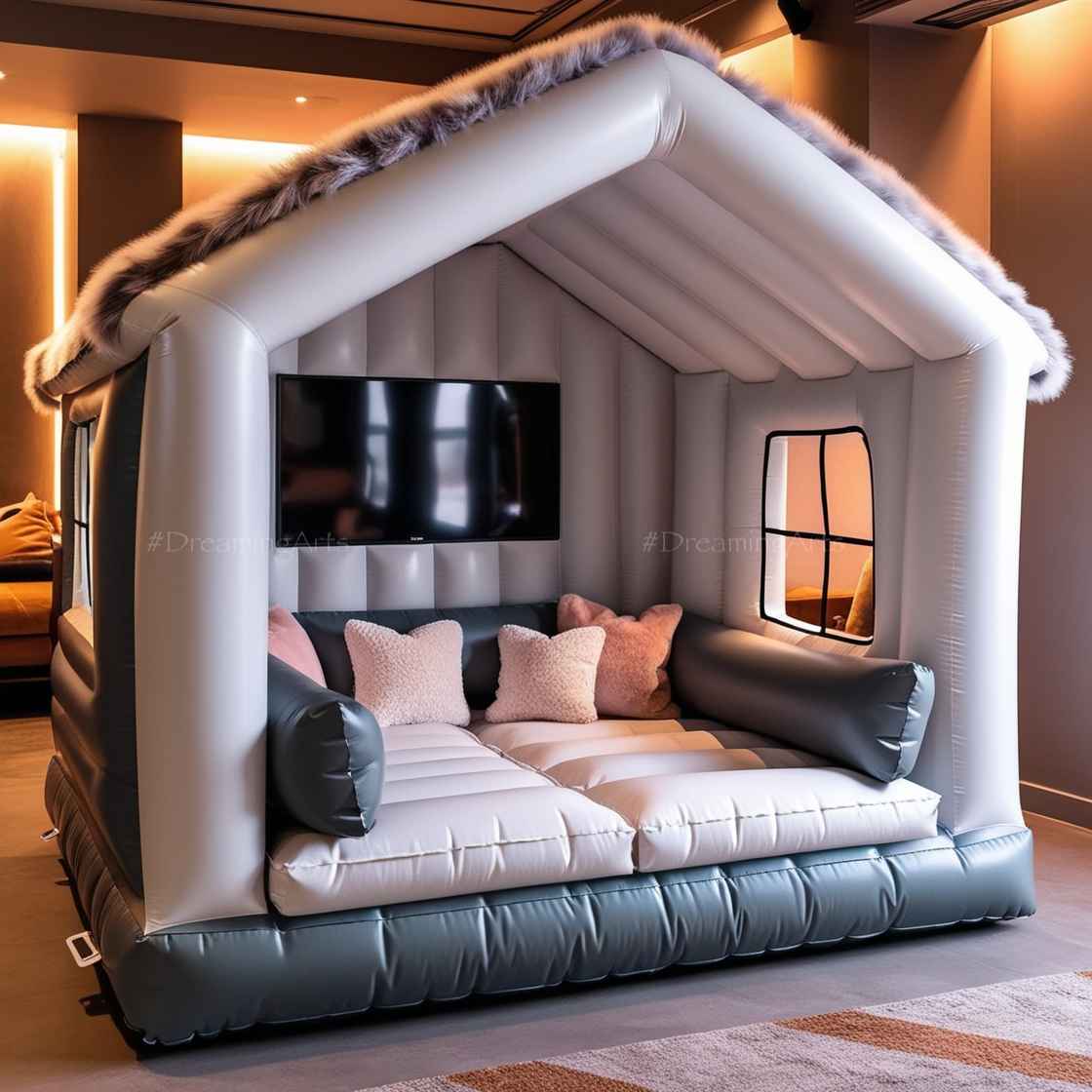
Minimalist Living
As minimalism gains traction, people are seeking furniture that doesn’t clutter their space. House Loungers align with this by being easy to store and multifunctional.
Nomadic Lifestyle
For digital nomads and frequent travelers, portable comfort is essential. House Loungers provide a homely touch wherever they go.
Social Media Influence
Platforms like Instagram and Pinterest have popularized aesthetically pleasing relaxation setups. House Loungers often feature in such content, inspiring others to adopt the trend.
Safety Considerations
While House Loungers are generally safe, it’s important to be mindful of certain aspects.
Weight Limits
Always adhere to the manufacturer’s specified weight limits to prevent accidents.
Stable Ground
Set up your lounger on stable, level ground to avoid tipping over, especially if children are using it.
Weather Conditions
Inflatable loungers can be affected by extreme temperatures. Avoid leaving them in direct sunlight for prolonged periods, which can cause the material to degrade.
Innovations in House Loungers
The industry is continually evolving, with new technologies enhancing the House Lounger experience.
Self-Inflating Models
Some loungers now feature self-inflating mechanisms powered by built-in pumps, eliminating the need for manual inflation.
Eco-Friendly Materials
Manufacturers are experimenting with organic and biodegradable materials to create sustainable loungers.
Integrated Technology
Advanced models come with features like USB charging ports, solar panels, and even Wi-Fi capabilities, turning your House Lounger into a modern relaxation hub.
Global Trends
House Loungers have a global appeal, with variations influenced by regional preferences.
Asian Markets
In countries like Japan and South Korea, compact living spaces make House Loungers an attractive option for home relaxation.
European Designs
European brands often focus on sleek design and high-quality materials, catering to a market that values aesthetics as much as functionality.
Outdoor Enthusiasts in Australia
With a strong culture of outdoor living, Australians have embraced House Loungers for beach outings and backyard gatherings.
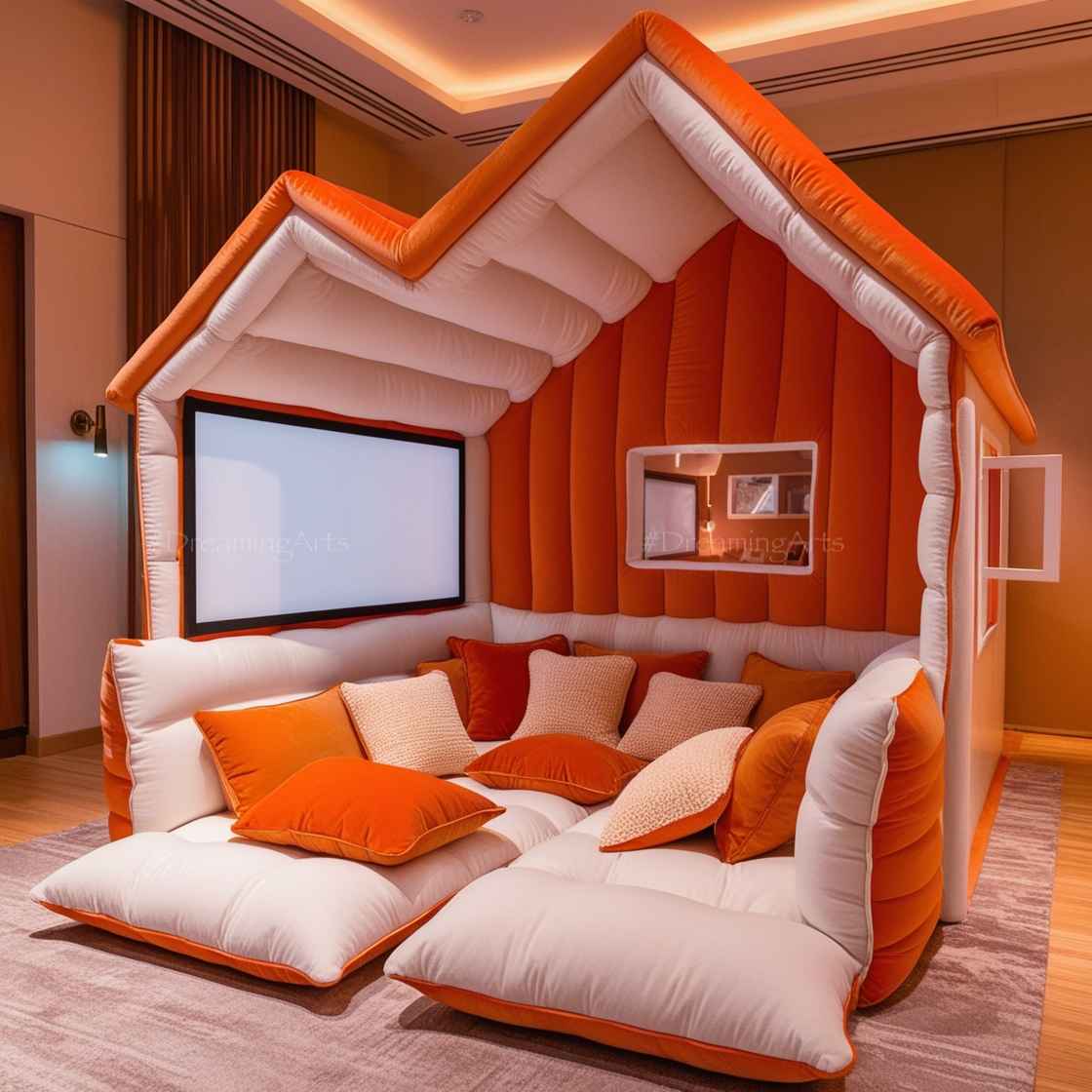
Environmental Responsibility
As consumers, we have a role to play in promoting sustainability.
Responsible Disposal
At the end of your lounger’s life, dispose of it responsibly. Check if the manufacturer offers a recycling program.
Supporting Sustainable Brands
Choose brands that prioritize eco-friendly practices, from material sourcing to production methods.
Community and Social Aspects
House Loungers can bring people together, fostering a sense of community.
Lounger Meetups
Events where enthusiasts gather to showcase their loungers and share experiences are becoming popular.
Charity Events
Some organizations use House Loungers in charity events to create comfortable spaces for participants, highlighting the lounger’s versatility.
Educational Uses
Educators are finding innovative ways to use House Loungers in learning environments.
Outdoor Classrooms
Schools and universities incorporate loungers into outdoor learning spaces, making lessons more engaging.
Reading Nooks
Libraries and reading centers use House Loungers to create inviting spaces that encourage reading and relaxation.
Comparing House Loungers to Traditional Furniture
When deciding between House Loungers and traditional furniture, several factors come into play.
Flexibility vs. Permanence
- House Loungers: Offer flexibility and can be moved or stored as needed.
- Traditional Furniture: Permanent fixtures that require significant effort to move.
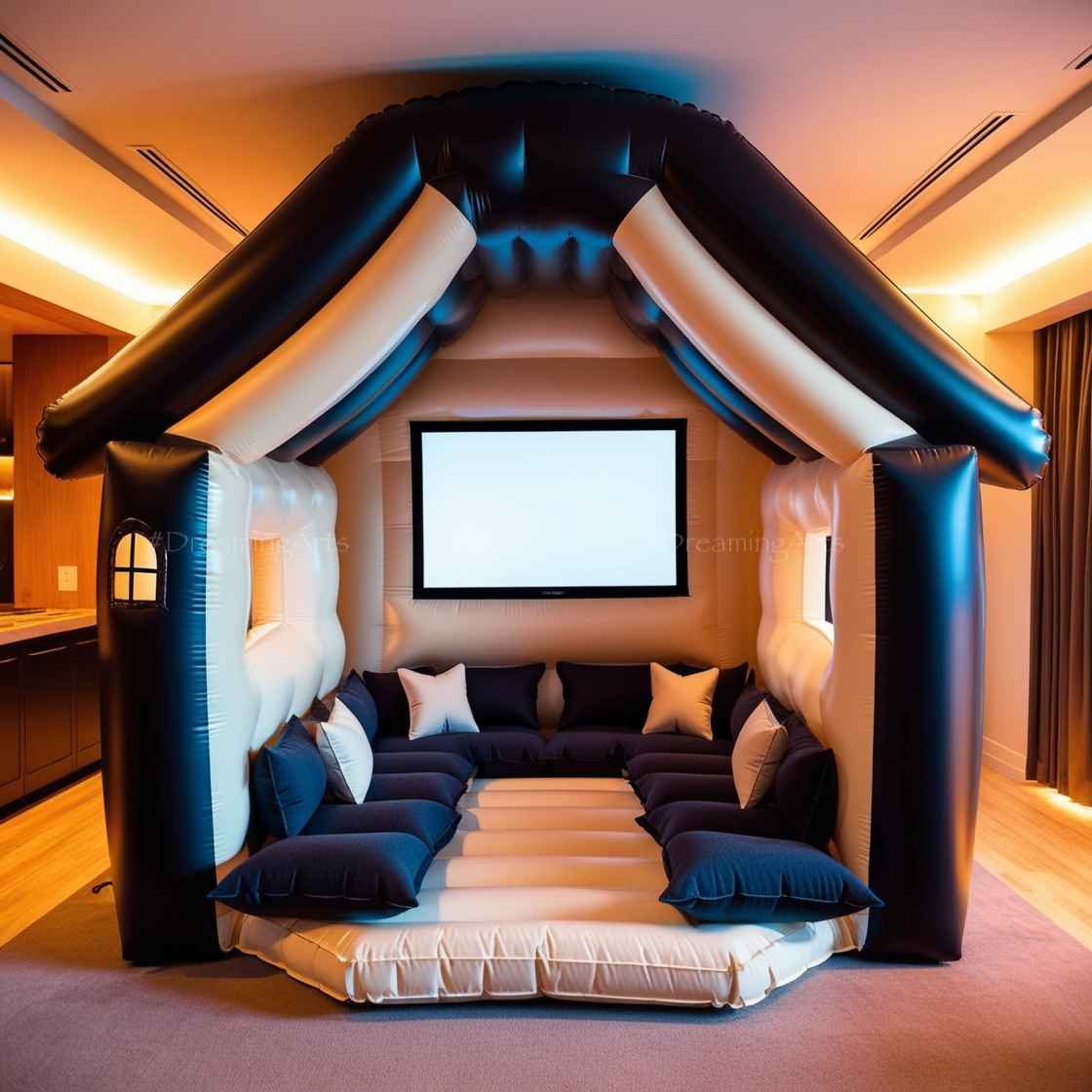
Cost Implications
- House Loungers: Generally more affordable upfront and incur lower maintenance costs.
- Traditional Furniture: Higher initial investment with potential additional costs for delivery and assembly.
Space Utilization
- House Loungers: Ideal for small spaces or multi-purpose rooms due to their collapsible nature.
- Traditional Furniture: Takes up permanent space, limiting room configurations.
Aesthetic Choices
- House Loungers: Modern designs with customizable options.
- Traditional Furniture: Wide range of styles from classic to contemporary.
Potential Drawbacks and How to Mitigate Them
While House Loungers offer numerous benefits, it’s essential to consider potential drawbacks.
Air Leaks and Punctures
- Issue: Inflatable products are susceptible to leaks.
- Solution: Choose loungers made from high-quality, puncture-resistant materials and keep a repair kit handy.
Stability Concerns
- Issue: Uneven inflation can lead to instability.
- Solution: Ensure even inflation and set up on flat surfaces.
Limited Weight Capacity
- Issue: Exceeding weight limits can cause damage.
- Solution: Check manufacturer specifications and choose a model that accommodates your needs.
Environmental Sensitivity
- Issue: Extreme temperatures can affect material integrity.
- Solution: Avoid prolonged exposure to harsh conditions and store the lounger appropriately.
Tips for Maximizing Comfort and Longevity
To get the most out of your House Lounger, consider the following tips.
Optimal Inflation
- Balance: Don’t overinflate; aim for a firmness that supports yet cushions.
- Adjustments: Be prepared to adjust inflation levels based on usage and preference.
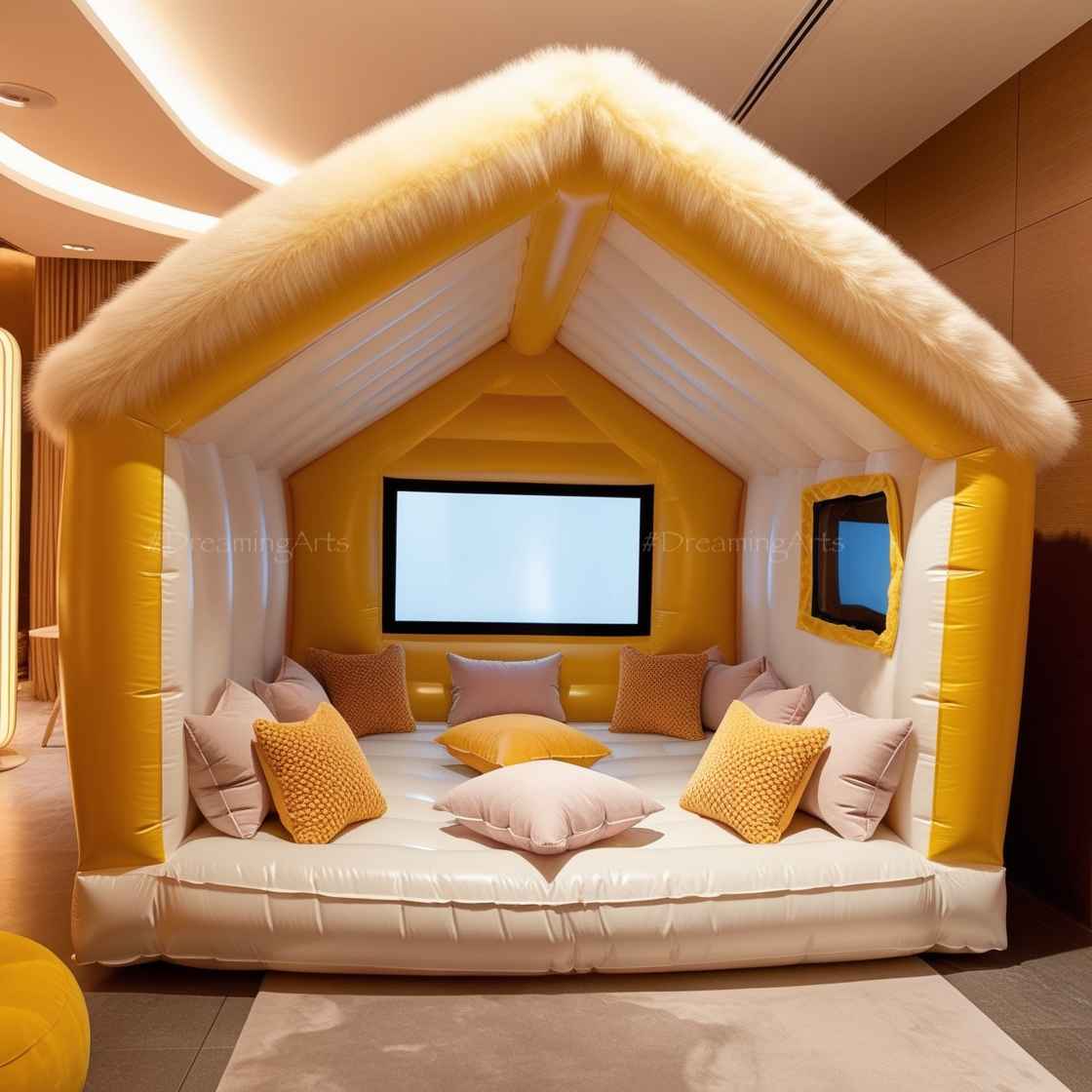
Regular Maintenance
- Cleaning: Regularly clean your lounger with mild soap and water.
- Inspection: Check for signs of wear and address issues promptly.
Accessorize Thoughtfully
- Comfort Items: Add pillows, throws, or mattress toppers for enhanced comfort.
- Protective Covers: Use covers to protect against spills or stains, especially if used outdoors.
Safe Storage Practices
- Deflation: Fully deflate and fold the lounger carefully to prevent creases or damage.
- Environment: Store in a cool, dry place away from direct sunlight.
House Loungers in Commercial Settings
Beyond personal use, House Loungers are making their way into commercial environments.
Hospitality Industry
Hotels and resorts incorporate House Loungers in poolside areas or private beach sections, offering guests a unique relaxation experience.
Event Planning
Event organizers use inflatable lounge houses to create VIP sections, children’s play areas, or themed lounges at festivals and corporate events.
Wellness Centers
Spas and wellness retreats utilize House Loungers for meditation rooms or relaxation zones, enhancing the therapeutic atmosphere.
Innovative Uses of House Loungers
Creative minds have found unconventional ways to use House Loungers.
Pop-Up Shops
Entrepreneurs set up temporary retail spaces using large House Loungers, benefiting from the easy setup and eye-catching designs.
Art Installations
Artists incorporate inflatable structures into their work, using House Loungers as interactive pieces that engage audiences.
Mobile Offices
Remote workers have transformed House Loungers into portable offices, providing a comfortable workspace that can be set up anywhere.
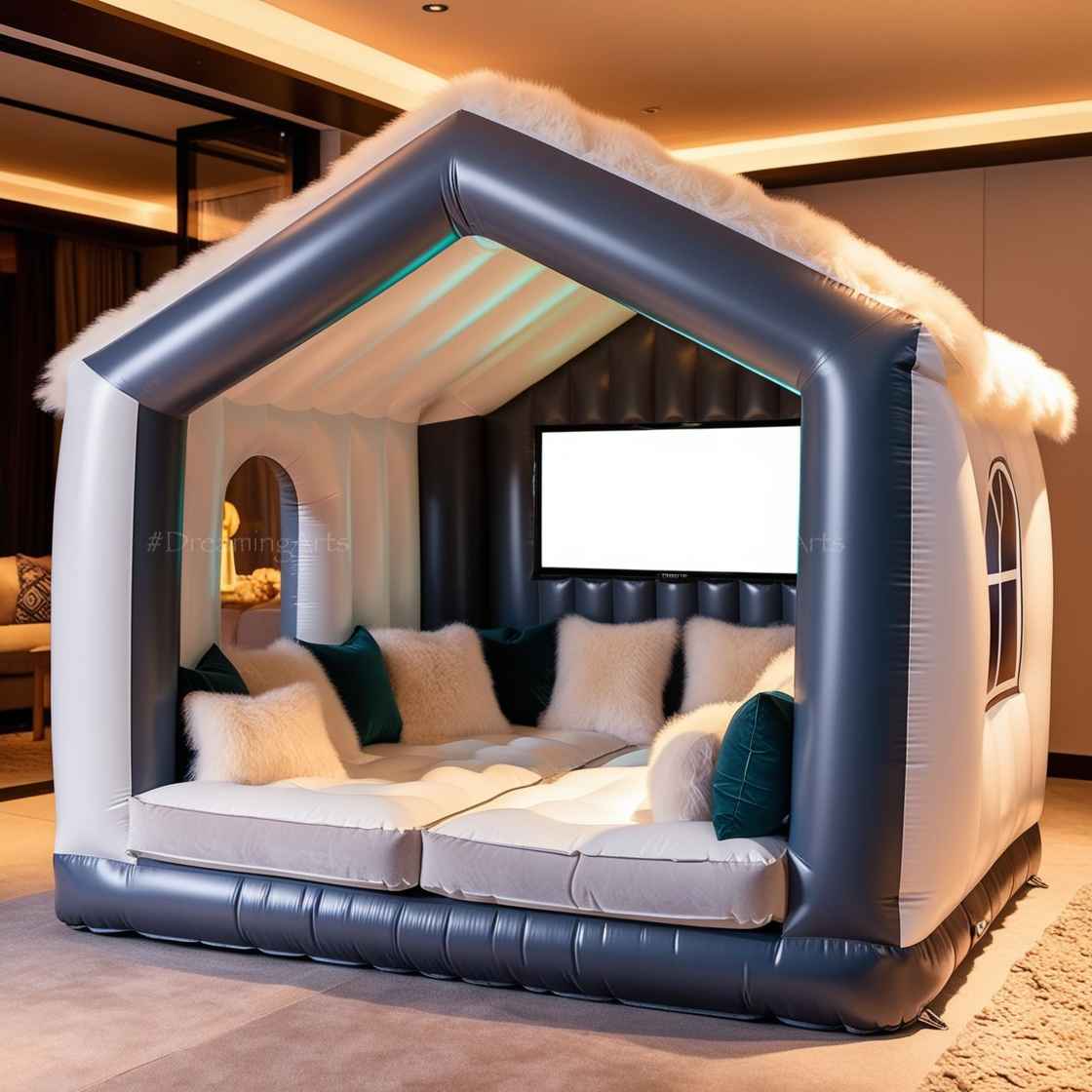
The Psychological Impact of a Comfortable Environment
Creating a space that promotes relaxation has profound psychological benefits.
Stress Relief
A comfortable lounging area can lower cortisol levels, helping individuals cope with daily stressors more effectively.
Increased Productivity
Paradoxically, taking time to relax can boost productivity. Regular breaks in a comfortable setting rejuvenate the mind.
Enhanced Creativity
Relaxed environments foster creativity. House Loungers provide a space where ideas can flow freely without the constraints of a traditional workspace.
Community Building Around House Loungers
Enthusiasts of House Loungers have formed communities to share their experiences and tips.
Online Forums and Social Media Groups
Platforms like Reddit and Facebook host groups where members discuss the latest models, share setup hacks, and organize meetups.
Collaborative Events
Communities often organize events like group camping trips or beach days, where participants can showcase their House Loungers and connect with like-minded individuals.
Environmental Considerations in Manufacturing
As sustainability becomes a priority, manufacturers are taking steps to reduce environmental impact.
Reduced Carbon Footprint
Efforts are being made to minimize emissions during production by optimizing manufacturing processes and sourcing local materials.
Recyclable Packaging
Eco-friendly packaging materials are being used to reduce waste and promote recycling.
Take-Back Programs
Some companies offer programs where old or damaged House Loungers can be returned for proper recycling or disposal.
The Role of House Loungers in Post-Pandemic Life
The global pandemic has reshaped how we view personal space and comfort.
Home Sanctuaries
With more time spent at home, individuals seek to create comfortable sanctuaries. House Loungers offer a way to carve out personal relaxation zones within limited spaces.
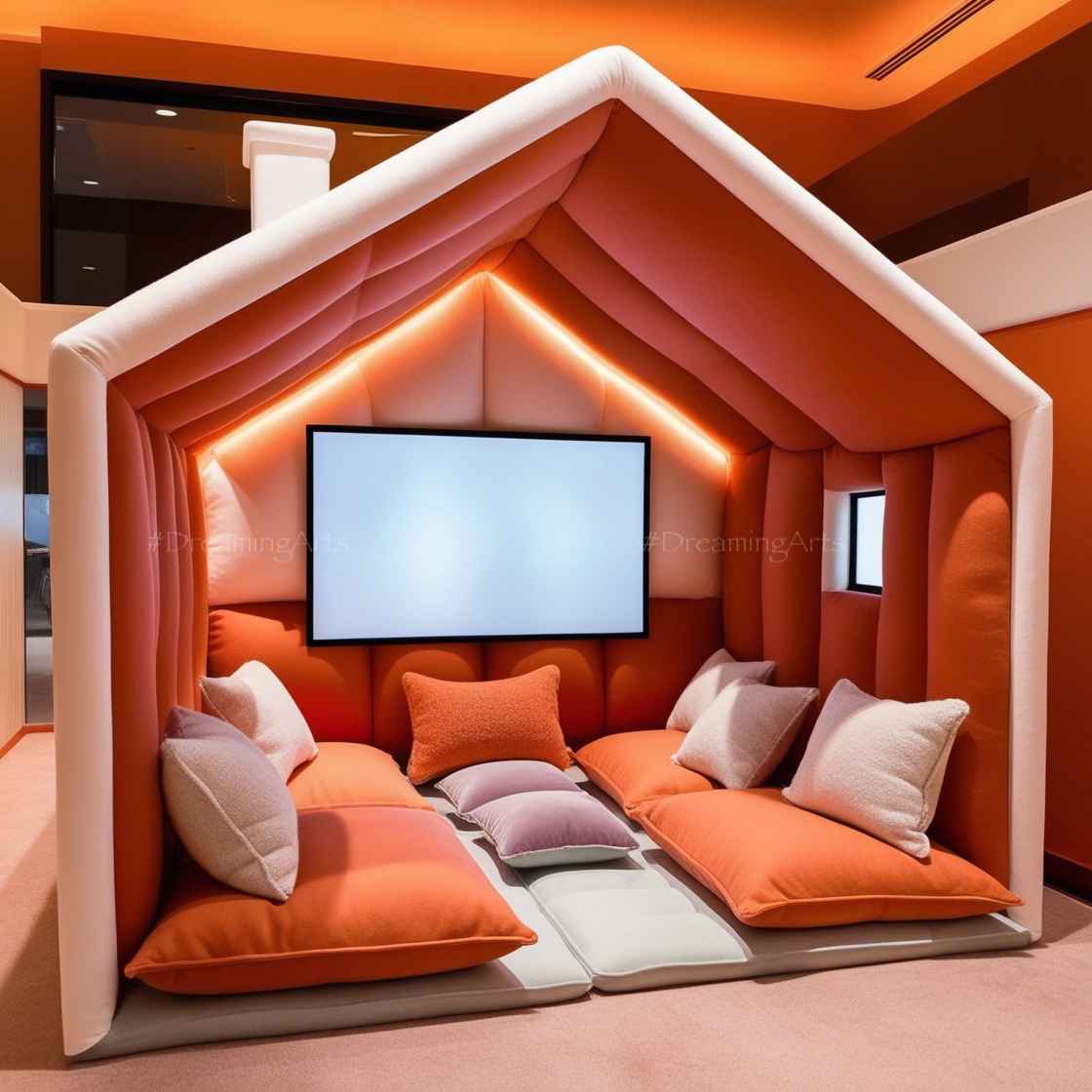
Outdoor Socializing
People are more inclined to meet outdoors. House Loungers facilitate comfortable and safe outdoor gatherings.
Mental Health Awareness
There is a growing emphasis on mental health. Investing in comfortable environments like those provided by House Loungers supports self-care practices.
The versatility and convenience of House Loungers make them more than just a piece of furniture—they’re a lifestyle choice. They represent a shift towards flexible living, where comfort and adaptability are paramount. By embracing House Loungers, you’re not just adding a functional item to your home or travel gear; you’re enhancing your quality of life. Whether you’re a busy professional needing a quick escape, a student looking for a cozy study spot, or a family wanting to maximize your outdoor fun, there’s a House Lounger that’s perfect for you.
Invest in a House Lounger today and discover a new dimension of relaxation and enjoyment. It’s more than an inflatable lounge house; it’s your personal sanctuary, ready to provide comfort whenever and wherever you need it.


